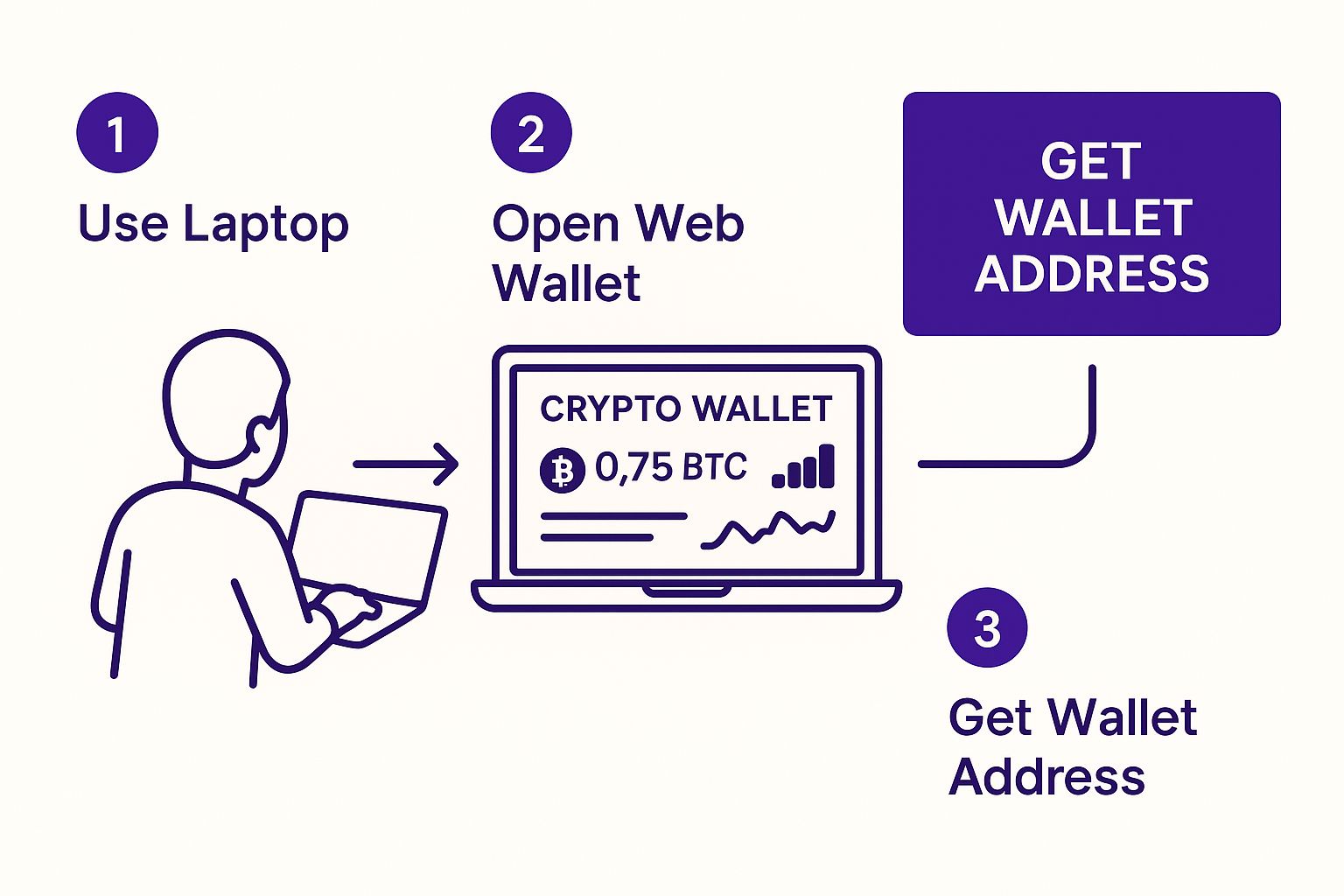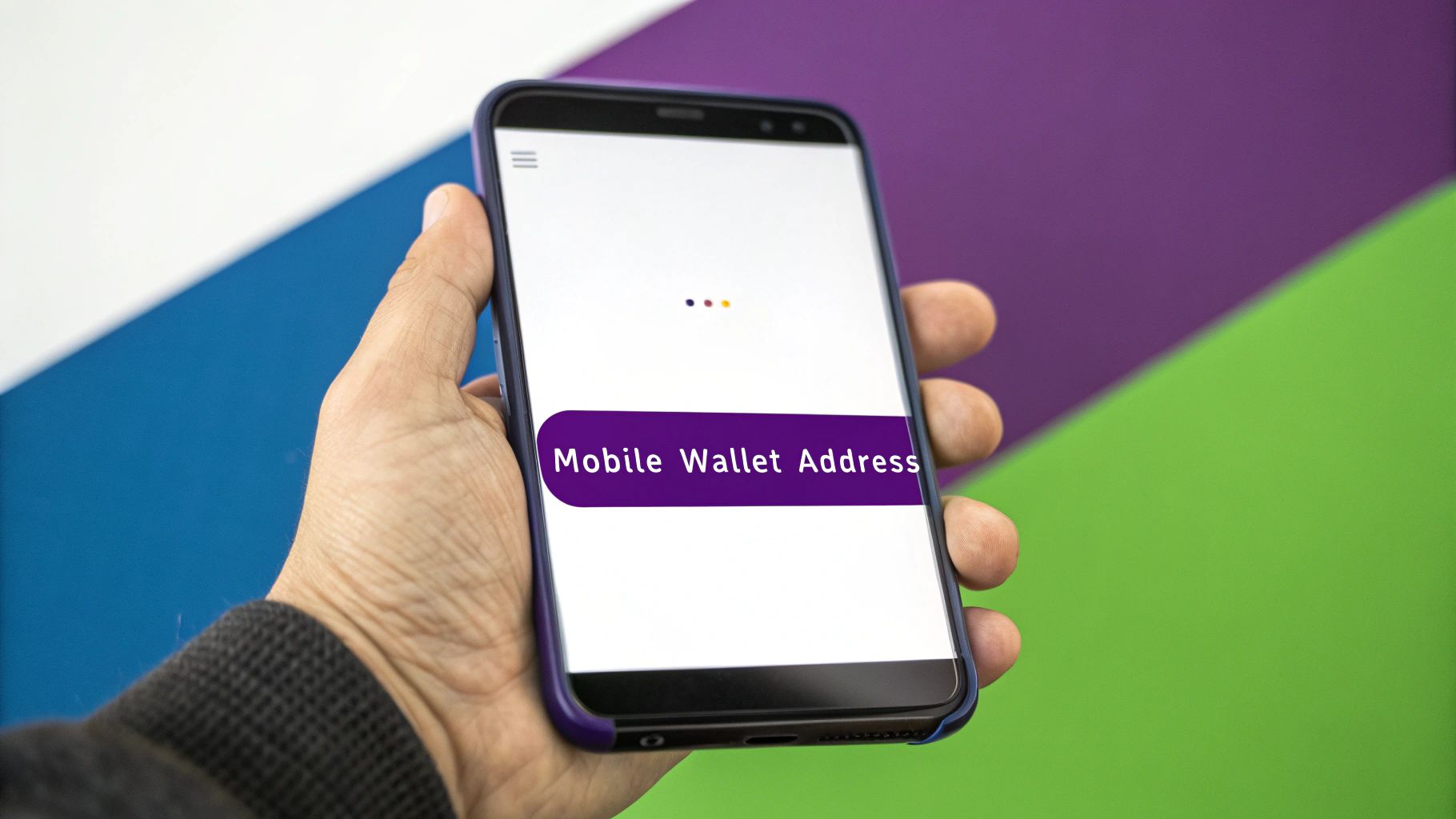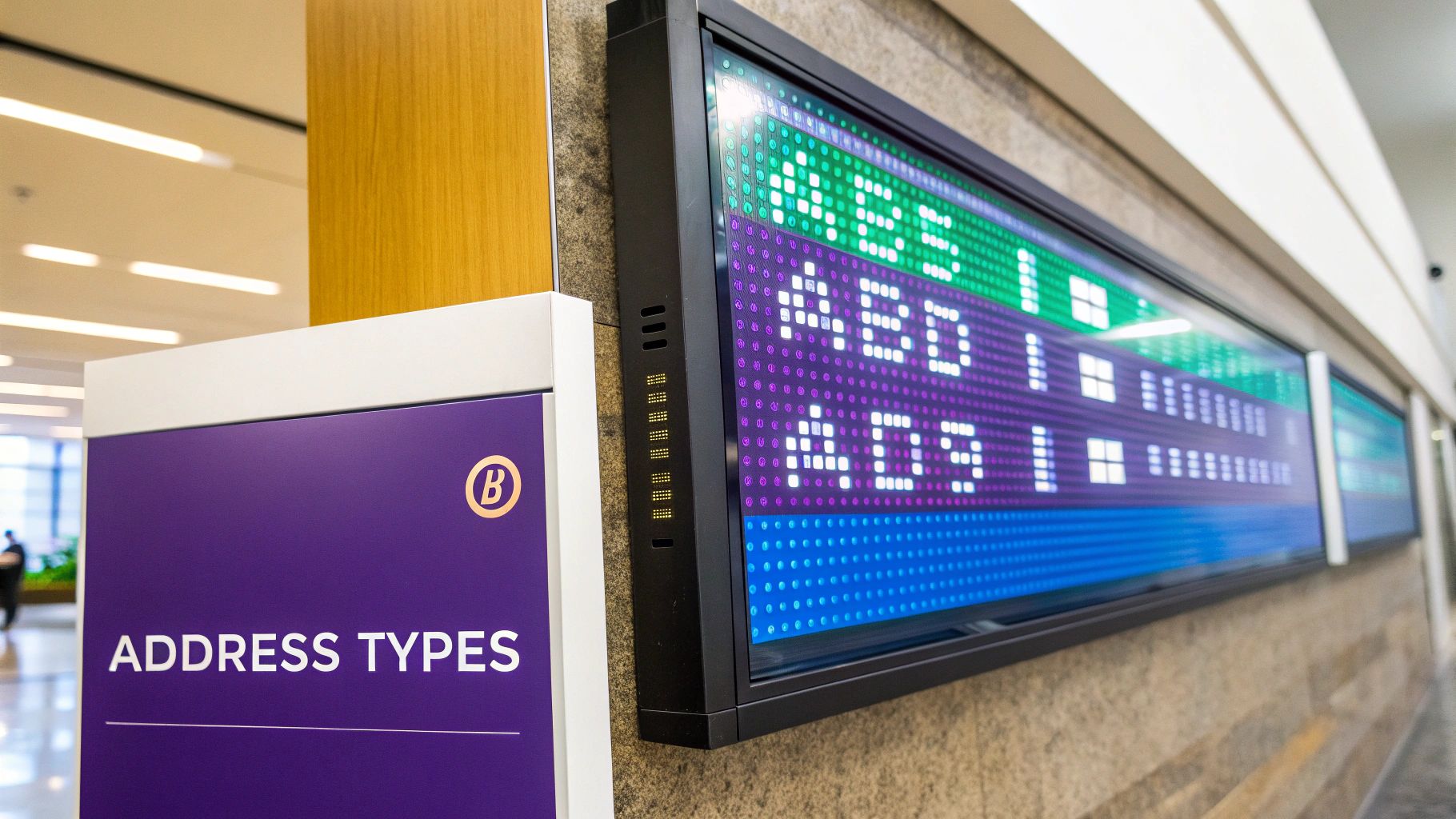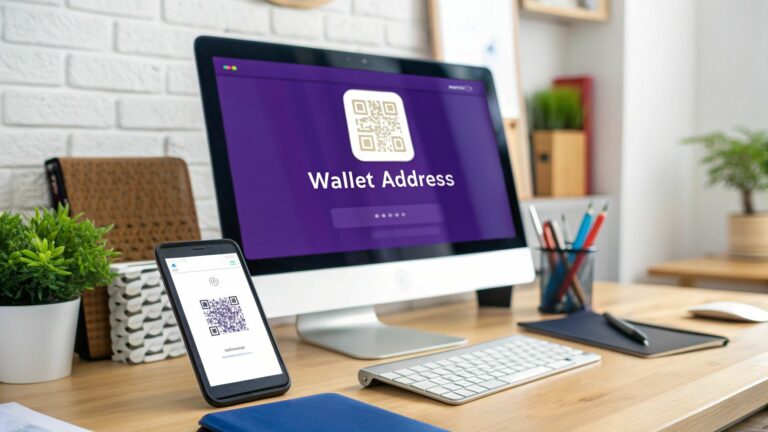Before you can receive any crypto, you need a wallet address. It's your unique identifier on the blockchain, a specific string of letters and numbers that tells the world exactly where to send digital assets.
Getting your hands on your wallet address is straightforward. You just open your crypto wallet app, find the "Receive" or "Deposit" section, and pick the cryptocurrency you want to accept. The app will show you the unique alphanumeric string for that specific coin, which you can copy, or a QR code you can share. Think of it as a digital bank account number, which you can safely give out to get paid.
Your Digital Mailbox For Crypto
To really get why this address is so crucial, it helps to have a grasp on what the blockchain is—the massive, public ledger where every single transaction gets recorded for all to see.
I like to think of a wallet as a digital mailbox. Your wallet address is the mail slot on the front. Anyone can see it and drop mail (or in this case, crypto) right into it. The crucial difference is that only you have the private key, which is the physical key needed to unlock that mailbox and get what’s inside.
Key Takeaway: Your public wallet address is for receiving funds and is totally safe to share. Your private key is for accessing those funds and must never be shared with anyone, ever.
Wallet Address vs Private Key Explained
It’s easy to get these two mixed up, but the distinction is critical for keeping your crypto safe. Here’s a quick breakdown to make it crystal clear.
| Component | Purpose | Can It Be Shared? |
|---|---|---|
| Wallet Address | To receive crypto from others. It's your public identifier on the blockchain. | Yes, this is public. Share it freely to get paid or receive transfers. |
| Private Key | To access and send crypto from your wallet. It proves ownership. | No, never share this. It's like giving someone the PIN to your bank account. |
In short, give out your address, but guard your private key with your life.
Why Your Address Is Essential
Without a wallet address, you simply can't operate in the crypto world. It's a foundational piece of the entire system. Every time you want to buy crypto on an exchange and move it into your personal wallet, get paid by a friend, or use a decentralized app, you'll need to provide this address.
We're passionate about making these interactions seamless, which is a core part of our mission here at vTrader. You can learn more about how we're working to support the ecosystem by checking out our story about the company.
The explosive growth of crypto is directly tied to the creation of these addresses. While there are hundreds of millions of Bitcoin wallets in existence, recent data suggests that around 25 million are actively used by individuals. That number highlights a massive amount of real-world engagement, and every single one of those active users had to get a wallet address to begin their journey.
Finding Your vTrader Wallet Address on a Computer
If you're using vTrader on your desktop, grabbing your wallet address is one of the first things you'll need to do to receive funds. Thankfully, the process is straightforward and designed to get you from the main screen to your address in just a couple of clicks. There's no need to wade through confusing menus.
Once you’ve logged into the vTrader desktop app, you’ll land on your main dashboard. From here, just look for a button labeled “Receive” or “Deposit.” It's usually in a pretty obvious spot. Clicking this is the first step to getting your crypto.

Selecting Your Crypto and Revealing the Address
After hitting “Receive,” the platform will ask you which cryptocurrency you want to accept. You’ll see a list with options like Bitcoin (BTC), Ethereum (ETH), and others. Just pick the one you’re expecting to receive.
Once you make your selection, the app instantly generates your unique wallet address for that specific crypto. You'll see the full alphanumeric string along with a scannable QR code. The interface makes it easy to either copy the full text address or let someone scan the QR code, which really helps cut down on mistakes.
Pro Tip: I can't stress this enough—always use the built-in “Copy” button. Trying to type out an address by hand is asking for trouble. One tiny typo could send your funds into the void, lost forever.
Here’s another good habit to get into: after you paste the address somewhere else (like an exchange or another wallet), always double-check the first and last four characters. This quick check is your best defense against a nasty scam called "address poisoning," where hackers spam your wallet with tiny transactions from addresses that look eerily similar to yours. They hope you'll accidentally copy their address from your transaction history instead of your own.
Getting these little security habits down makes the whole process of managing your crypto much safer. If you want to dive deeper into wallet security and other crypto essentials, the vTrader Academy has some great tutorials and resources.
Getting Your Wallet Address on the vTrader Mobile App

When you’re out and about, managing your crypto portfolio requires a different playbook. The vTrader mobile app is designed for exactly that—speed and simplicity. Pulling up your wallet address is just as straightforward as on a desktop, but it comes with a few mobile-friendly features that make a world of difference when you're on the move.
Fire up the vTrader app to get started. You can use your phone’s biometrics—like Face ID or a fingerprint scan—to log in, which is always a nice touch for security. Once you’re in, you’ll want to navigate to the 'Wallet' or 'Assets' tab, which you’ll typically find in the main navigation menu at the bottom of your screen.
Tapping to Your Address
Inside your wallet, you'll see a list of all your holdings. Just tap on the cryptocurrency you want to receive, whether it's Bitcoin, Ethereum, or any other digital asset in your portfolio. This opens up a detailed view for that specific coin, showing your balance and transaction history.
Here, look for a button clearly marked ‘Receive.’ A single tap will bring up everything you need. You'll instantly see two critical pieces of information:
- The Full Alphanumeric Address: This is the long string of text and numbers. A simple tap usually copies it right to your clipboard.
- A Scannable QR Code: The familiar black-and-white square that makes in-person transactions a breeze.
This is where the mobile experience really shines. If you’re with a friend who owes you some crypto, they can just scan your QR code with their own phone. It’s instant, and it completely removes the risk of sending funds to the wrong address because of a typo.
The sheer convenience of mobile wallet access is a huge driver behind crypto's daily use. Take the Tron network, for instance, which sees around 2.9 million active addresses every day—a figure that dwarfs Bitcoin's 887,000. These numbers reflect real people making transfers, a process made incredibly smooth by well-designed mobile apps. You can explore more data on crypto user engagement and discover more insights on daily active addresses at Statista.com.
Another killer feature is the built-in share function. You can tap the share icon to send your wallet address directly through a messaging app like WhatsApp or Telegram. It keeps the whole process contained, quick, and, most importantly, accurate.
Safely Managing and Sharing Your Wallet Address
Getting your wallet address is just the first step. The real challenge—and where many newcomers stumble—is handling it with a security-first mindset to protect your assets. How you manage your address from here on out will define your safety in the crypto world.
One of the most common mistakes I see is startlingly simple: people get careless. A frequent error is posting a wallet screenshot online, proudly displaying not just the address but the entire balance. Doing this is like painting a massive target on your back for every scammer and hacker prowling the web. Always, always crop out sensitive details like your balance before you even think about sharing.
Another insidious threat lurking in the background is clipboard-hijacking malware. This nasty bit of code runs silently on your device, just waiting for you to copy a crypto address. The moment you do, it swaps your intended address with one belonging to an attacker. You paste it, hit send without a second thought, and just like that, your funds are gone forever.
Develop Strong Security Habits
You can fend off most of these threats by building a few consistent security habits. These aren't complicated routines, but they make a world of difference in keeping your funds where they belong.
- Always Double-Check: Before you confirm any transaction, make it a reflex to verify the first four and last four characters of the address you just pasted. This simple check is your best defense against most clipboard attacks.
- Isolate Large Holdings: If you're holding a significant amount of crypto, you should seriously consider moving it to a dedicated hardware wallet. Think of your vTrader wallet as a checking account for daily trading and your hardware wallet as a secure savings vault.
- Practice Privacy: Reusing the same public address for every transaction creates a permanent, public record of your entire financial history on the blockchain. Modern wallets like vTrader help by generating fresh addresses for transactions, which is a feature you should definitely use to protect your privacy.
Key Insight: Treat your primary wallet address like you would your bank account details. The goal isn't just to receive funds but to manage your crypto securely. Your personal security practices are a vital part of a successful crypto strategy. For more details on your responsibilities, it's worth reviewing our terms and conditions, which outline best practices.
The global surge in crypto adoption brings both opportunities and risks. It’s no coincidence that regions with the highest adoption rates also report more security incidents, which just highlights how critical user education has become.
Of course, secure financial practices extend beyond the crypto space. For anyone operating online, mastering other payment systems is equally vital. For instance, understanding the ins and outs of setting up PayPal subscription payments is key to managing recurring revenue securely and efficiently.
Why You Might Have Multiple Wallet Addresses

If you're getting more involved in crypto, you’ve probably noticed something curious: you don't seem to have just one wallet address. Seeing a different string of characters pop up can be a bit jarring at first, but rest assured, it’s not a system glitch. It's actually a key feature of how modern, secure wallets operate.
The most straightforward reason is that different blockchains speak different languages. A Bitcoin address, for instance, is built exclusively for the Bitcoin network and simply won't work for receiving Ethereum. It’s a bit like trying to deposit US dollars into a Japanese yen bank account—the two systems are fundamentally incompatible.
New Addresses Are a Privacy Power-Up
Beyond the network specifics, there's a more advanced reason you'll see changing addresses. Wallets like vTrader automatically generate a brand-new address every time you go to receive crypto. This isn't just for show; it’s a powerful privacy mechanism driven by Hierarchical Deterministic (HD) wallet technology.
Think about it: if you used the same address for every single transaction, anyone could look it up on the public blockchain and trace your entire financial history. HD wallets solve this by creating a fresh address for each deposit, all of which are mathematically tied to a single master key that only you control. You get the privacy without the headache of managing dozens of separate wallets.
Privacy Takeaway: Making it a habit to use a new address for every transaction is a cornerstone of good crypto hygiene. It throws trackers off your trail, making it much harder for anyone to connect the dots and map out your financial activities.
This is precisely why the "receive" address you see in your vTrader app today might look completely different from the one you used last week. Both are yours, and both are valid. While you can technically reuse an old address, the best practice is always to use the fresh one the wallet provides. It's a simple step that significantly boosts your privacy, especially if you're looking to grow your portfolio through methods like those in our guide on how crypto staking works.
Common Questions About Wallet Addresses
As you get more comfortable using crypto, you'll naturally start asking deeper questions. Getting a handle on how your wallet address works—and how to manage it safely—is a huge part of building confidence. Let's tackle some of the most common questions we see from users.
Is My Wallet Address Permanent?
This is a classic "yes and no" situation. Technically, any address your wallet generates is permanently tied to your private key. It can receive funds forever. So, if a friend sends Bitcoin to an address you used two years ago, don't worry—it will land safely in your wallet.
However, modern wallets like vTrader prioritize your privacy and security. That's why they generate a fresh address every single time you go to receive funds. This is a crucial best practice. While your old addresses never expire, using a new one for each transaction makes it much more difficult for anyone to track your financial history on the public blockchain.
Takeaway: Your old addresses don't expire, but you should always use the new one your wallet provides for each transaction. Think of it as a free, built-in privacy tool.
What Happens If I Send Crypto to the Wrong Address Type?
This is one of the most common—and most painful—mistakes in crypto. Sending a coin to an address built for a different blockchain is a surefire way to lose your funds. For instance, sending Bitcoin (BTC) to an Ethereum (ETH) address means those funds are almost certainly gone for good.
The two networks are completely separate; they don't speak the same language. It's like mailing a letter to an address that doesn't exist. There's nowhere for it to go, and it can't be returned. Always, always double-check that the address you're sending to matches the cryptocurrency you're sending. Most wallets, including vTrader, have safeguards to help prevent this, but the final responsibility is yours.
How Many Wallet Addresses Can I Have?
You can have a practically unlimited number of wallet addresses. This is thanks to modern Hierarchical Deterministic (HD) wallets, which can generate billions of unique addresses from a single master private key.
It's why your vTrader wallet can give you a brand-new address for every single transaction you'll ever make, across all the different cryptos you hold. For all practical purposes, there's no limit to the number of addresses your wallet can create and manage for you.
Can Someone Steal My Crypto with Just My Address?
No, your funds are safe if someone only has your public wallet address. Think of it like your bank account number—it's meant to be shared so you can receive money. It provides zero access to the funds inside.
The real risk isn't theft, but privacy. Sharing your address allows others to look up your balance and transaction history on a public block explorer. Scammers also exploit this by using tricks like address poisoning, where they send you a tiny amount of crypto from a wallet address that looks almost identical to one you've used before, hoping you'll accidentally copy and paste their address on your next transaction.
This is exactly why verifying the full address before you hit "send" is so critical. For more in-depth answers to these kinds of questions, our comprehensive vTrader FAQ page is an excellent resource.
Ready to trade with confidence on a secure, commission-free platform? Join vTrader today and get a $10 bonus to start your portfolio. Start trading now.

Steve Gregory is a lawyer in the United States who specializes in licensing for cryptocurrency companies and products. Steve began his career as an attorney in 2015 but made the switch to working in cryptocurrency full time shortly after joining the original team at Gemini Trust Company, an early cryptocurrency exchange based in New York City. Steve then joined CEX.io and was able to launch their regulated US-based cryptocurrency. Steve then went on to become the CEO at currency.com when he ran for four years and was able to lead currency.com to being fully acquired in 2025.


